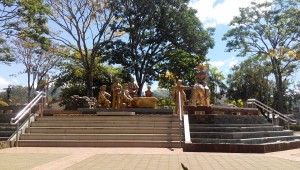“South Summer Capital of the Philippines”
Legend says that Malaybalay got its name during an encounter of the local children of the place to the Spanish explorers. These explorers met children playing at the lower part of the Sawaga. The saoldiers asked these children about the name of the place. Thinking that the explorers were asking about what they were doing, the children answered “tagbalaybalay kay” (we are playing house). The soldiers thought the name of the place was Malaybalay, so they record the name Malaybalay as the name of the place since then.
History

Original inhabitants of Malaybalay came from the seashores of Northern Mindanao who were driven towards the mountains due to the attacks of the pirates and the arrival of the Spanish colonizers. In 1850, Kalasungay (an old settlement of Malaybalay) was burned down by the Spaniards during their final battle with the lumads. All male adults were killed and thw women and children were taken as hostages. This battle was the last recorded fight between the locals and the Spanish conquerors. Few days after their defeat, the survivors of the battle who fled to Silae slowly returned to the area and established a new settlement near the Sacub River (present day Rizal Prk) under the lead of Datu Mampaalong. They then accepted the Spanish dominion and embraced Christianity on June 15, 1877.
August 20, 1907, the Philippine Commission Act No. 1693 was enacted creating the Province of Agusan and the sub-province of Bukidnon. Malaybalay became an independent municipality on October 19, 1907. When Bukidnon was declared as a regular province, Malaybalay was designated as its provincial capital.
During the Second World War in 1942, the Japanese occupation troops entered Bukidnon and occupied Malaybalay, establishing a camp in Casisang. In 1945, American libertation forces, together with the Philippine Commonwealth Forces and Filipino guerrillas liberated Malaybalay.
On February 11, 1998, President Fidel Ramos signed the act (R.A. 8490) that converted Malaybalay to a city, making it the first component city of Bukidnon.
Population/ Language/ Area
Malaybalay City, the capital city of Bukidnon is in the central part of the province. It is bounded in the east by the municipality of Cabanglasan and the Pantaron Range, which separates Bukidnon from the provinces of Agusan del Sur and Davao del Norte; on the west by the municipality of Lantapan and Mount Kitanglad; on the north by the municipality of Impasug-ong; and on the south by Valencia City and the municipality of San Fernando.[9][10]
The whole eastern and southeastern border adjoining Agusan del Sur and Davao del Norte is elevated and densely forested mountains, which is one of the few remaining forest blocks of Mindanao.
The nearest seaports and airports are in Cagayan de Oro City, which is 91 kilometers away.
The total land area of the city is reaching up to 984.38 km2 (380.07 sq mi) with a total population of 153, 085 as of 2010.
Products and Services
Major industries in Malaybalay are agri-based such as poultry and piggeries. Big corporations can also be found here such as San Miguel, Purefoods, Monterey, Swift, Asian Hybrid Philippines (feeds processing), Rubbertex (rubber shoes manufacturing), and Monastery Farms (peanuts and other preserved foods). Cattle ranches can also be found here.
Tourist Spots
- Mt. Capistrano – this mountain served as the evacuation area during the World War II. Now it is characterized by its unique rock formations and challenging caves.
- Kaamulan Grounds – located at Brgy. 1, Kaamulan Grounds. This place is serving as an activity area, place of refuge, picnic and other outdoor activities. Pine trees are around the park. The Folk Arts Theater where some provincial activities and events are held, is also found here.
- Bukidnon Forest Inc., (BFI) Industrial Tree Plantation – This 39,000-hectare reforestation project (21,000 hectares of which are plantable) demonstrates the compatibility of nature with economic objectives. Funded with the assistance of the New Zealand government under the auspices of DENR, the project has been operational since 1990. The City of Malaybalay and the municipalities of Impasugong, Manolo Fortich and Malitbog are the areas covered by the plantation. Its 5-hectare nursery is capable of producing 5.2 million fast-growing seedlings every year.
- Bird Watch Tower – this tower can be found in Barangay Dalwangan. Variety of birds, some of which are already endangered, can be found here.
- Mount Katinglad – very ideal for mountain climbing. The mountain is said to be the 2nd highest peak in the Philippines with 9,636 feet above sea level. The place is also a national park and serves as the protected habitat for the endangered Philippine eagle.


